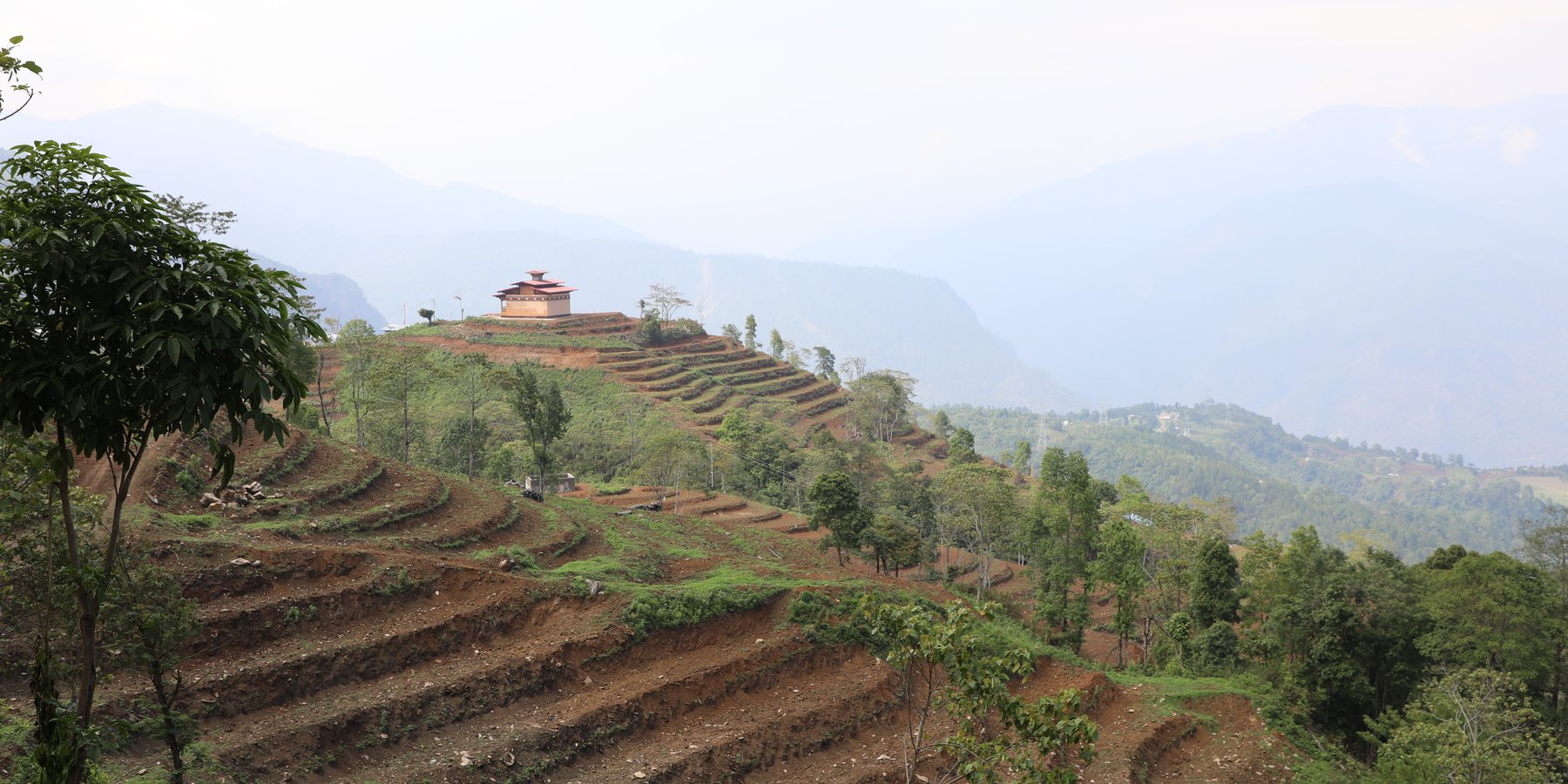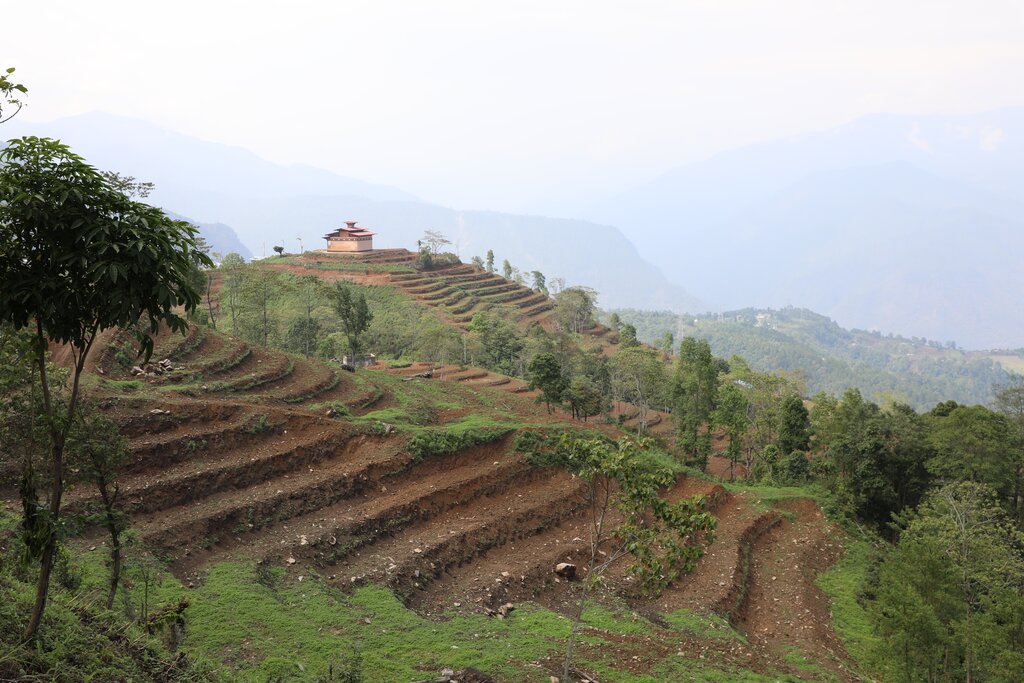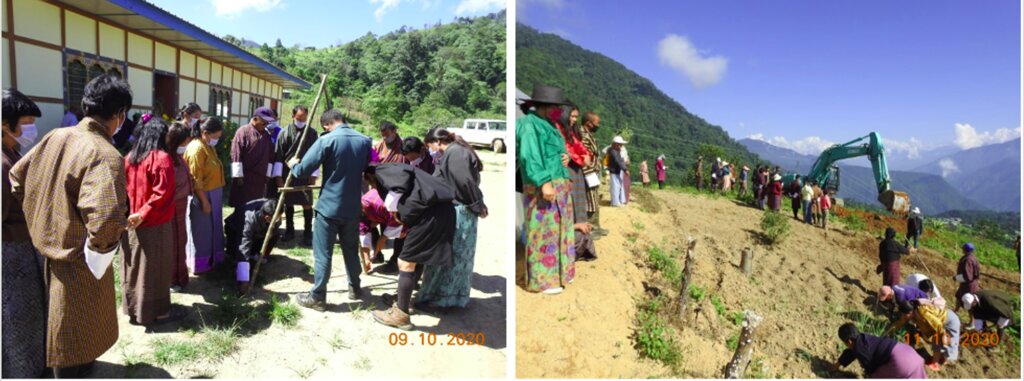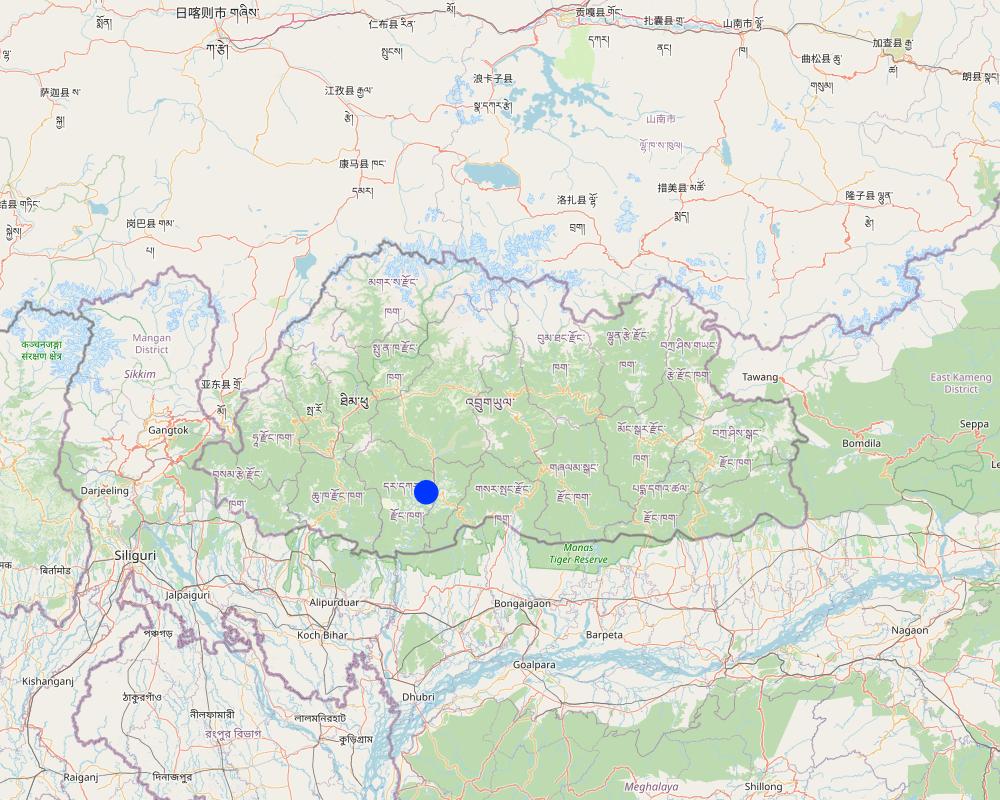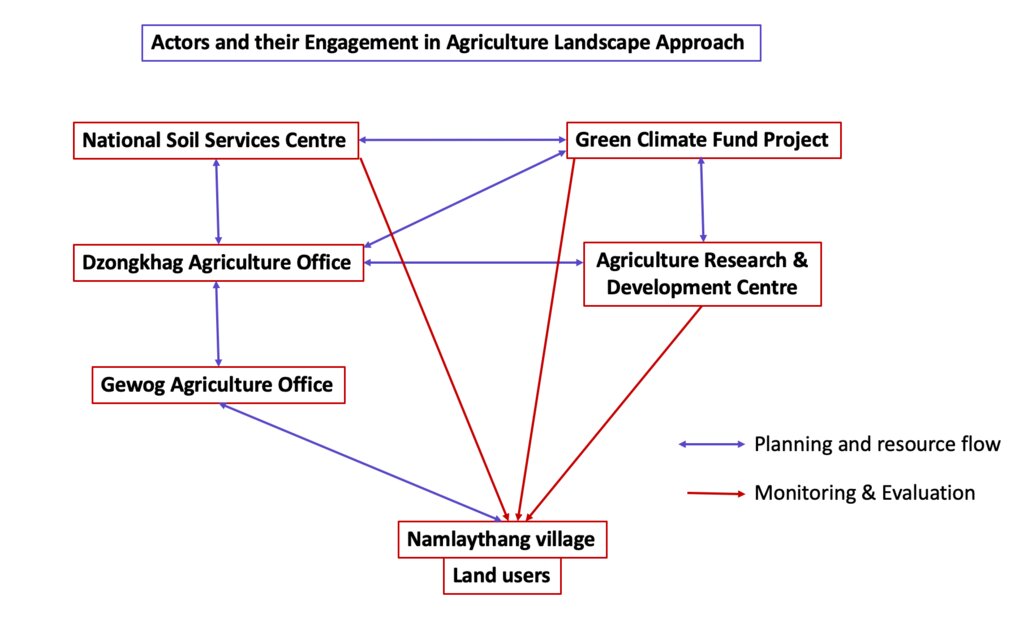Agricultural Landscape Approach for SLM Implementation [Bhutan]
- Creation:
- Update:
- Compiler: Nima Dolma Tamang
- Editor: Tashi Wangdi
- Reviewers: William Critchley, Rima Mekdaschi Studer
སའི་ཆགས་ཐངས་དང་འཁྲིལ་ཡུན་བརྟན་ས་གཞི་འཛིན་སྐྱོང་ལག་ལེན་འཐབ་ཐངས།
approaches_6848 - Bhutan
View sections
Expand all Collapse all1. General information
1.2 Contact details of resource persons and institutions involved in the assessment and documentation of the Approach
Key resource person(s)
land user:
Dorji Damchoe
+97577463000
Namlaythang village, Tsangkha Gewog, Dagana Dzongkhag
Bhutan
land user:
Tsagay
77438522
Namlaythang village, Tsangkha Gewog, Dagana Dzongkhag
Bhutan
land user:
Dema Jigme
17405863
Namlaythang village, Tsangkha Gewog, Dagana Dzongkhag
Bhutan
land user:
Wangda Yeshi
17888916
Namlaythang village, Tsangkha Gewog, Dagana Dzongkhag
Bhutan
land user:
Norbu Nyagay
17504186
Namlaythang village, Tsangkha Gewog, Dagana Dzongkhag
Bhutan
Name of project which facilitated the documentation/ evaluation of the Approach (if relevant)
Strengthening national-level institutional and professional capacities of country Parties towards enhanced UNCCD monitoring and reporting – GEF 7 EA Umbrella II (GEF 7 UNCCD Enabling Activities_Umbrella II) {'additional_translations': {}, 'value': 6392, 'label': 'Name of the institution(s) which facilitated the documentation/ evaluation of the Approach (if relevant)', 'text': 'National Soil Services Centre, Department of Agriculture, Ministry of Agriculture & Livestock (NSSC) - Bhutan', 'template': 'raw'}1.3 Conditions regarding the use of data documented through WOCAT
When were the data compiled (in the field)?
11/07/2023
The compiler and key resource person(s) accept the conditions regarding the use of data documented through WOCAT:
Yes
2. Description of the SLM Approach
2.1 Short description of the Approach
The Agricultural Landscape Approach in Sustainable Land Management is a holistic and integrated strategy that focuses on managing agricultural landscapes in a sustainable manner. The approach was successfully initiated in Namlaythang village and transformed the whole agricultural landscape covering 107 acres (43 ha) while benefitting 55 resettled households.
2.2 Detailed description of the Approach
Detailed description of the Approach:
The Agriculture Landscape Approach in Sustainable Land Management (SLM) is a holistic and integrated strategy that focuses on managing agricultural landscapes in a sustainable manner. This approach recognizes the interrelation of various elements within a landscape, including soil, water, biodiversity, and human activities, ultimately aiming to optimize the benefits derived from these interactions while minimizing negative environmental impacts.
This approach was initiated in Namlaythang village under Tsangkha gewog (block), Dagana Dzongkhag (district). Namlaythang was chosen for this approach because it is a new settlement with 55 resettled households who were granted land ranging from 1.75 to 3 acres (0.7 to 1.2 hectares) per family by His Majesty the King as per the National Rehabilitation Program. Since the area was recently cleared and converted to settlement and farming, there was a huge risk of land degradation due to direct exposure to rain and unsustainable agriculture practices. Therefore, it was not only timely to implement SLM to prevent land degradation but also appropriate to have adopted the Agricultural Landscape Approach by engaging the whole community.
The main aim of adopting the agricultural landscape approach was to bring transformational change at a scale. Too often, we plan and implement SLM interventions supported by different projects in small, localized areas and in a scattered manner. This limits the ability to scale out success (both spatially and temporally) despite being positive initiatives. The approach was also intended to facilitate a multi-stakeholder platform by bringing relevant stakeholders together to discuss common objectives and draw synergies across different agencies.
The process started by discussing the idea with the Dzongkhag and gewog agriculture offices followed by sensitization of land users on the importance of SLM and its technologies. This was followed by Participatory SLM Action planning wherein detailed action plans were prepared based on landowners’ interest, feasibility of their land and the available technologies. The next mandatory activity carried out before implementation of SLM in the field was the conduct of field based hands-on training of the land users. The main SLM technologies planned and implemented included terracing, stone bunds, hedgerows, check dams/ gully plugs and plantations. In addition, climate resilient agriculture practices were also promoted such as greenhouses, low-cost water harvesting ponds, drip irrigation sets and fruit tree plantations.
In promoting this approach and other technologies, several stakeholders were involved including the Dzongkhag and gewog agriculture offices, National Soil Services Center (NSSC), Agriculture Research and Development Center, Bajo (ARDC-Bajo), the landowners and a Green Climate Fund (GCF) Project. The agricultural offices provided the overall coordination and the facilitation role in implementing the approach and its associated technologies. The NSSC provided sensitization and training on SLM technologies and also facilitated participatory SLM Action Planning with the landowners and other stakeholders. Similarly, the ARDC-Bajo arranged material inputs for climate resilient agriculture practices and provided technical assistance to the landowners and the gewog agriculture extension officer. The GCF Project provided financial support based on the action plan.
The implementation of SLM and climate resilient agriculture practices following agricultural landscape approach in Namlaythang have been a great success. The approach has brought a transformational change at the landscape level through various SLM interventions which collectively contributed towards reduction of soil erosion and nutrient loss, conservation of soil moisture and the improvement of overall soil health and food security. The land users also feel empowered through sensitization, capacity building and their engagement in the whole process. In brief, the land users expressed their satisfaction with the approach and the impacts it has created in the agricultural landscape which is the basis of their livelihoods.
A major weakness of the approach is that there is no institution/group/cooperative formed for efficient coordination among the land users and other stakeholders which questions its sustainability.
2.3 Photos of the Approach
2.4 Videos of the Approach
Date:
11/07/2023
Name of videographer:
Chimi Yangki
2.5 Country/ region/ locations where the Approach has been applied
Country:
Bhutan
Region/ State/ Province:
Dagana Dzongkhag
Further specification of location:
Goongpa-Soomchu Chiwog, Tsangkha Gewog
Map
×2.6 Dates of initiation and termination of the Approach
Indicate year of initiation:
2020
2.7 Type of Approach
- project/ programme based
2.8 Main aims/ objectives of the Approach
To bring about transformational change through project intervention at the landscape level.
2.9 Conditions enabling or hindering implementation of the Technology/ Technologies applied under the Approach
social/ cultural/ religious norms and values
- enabling
The strong community cooperation
availability/ access to financial resources and services
- enabling
The SLM and climate resilient agriculture technologies were implemented with financial support provided by the government through a Green Climate Fund (GCF) project
institutional setting
- enabling
The land users implement a labour-sharing system where all the land users come together to work in the field and go to the next after completion of that field. They take turns to work in the field of all the land users.
collaboration/ coordination of actors
- enabling
All the relevant stakeholders (Dzongkhag, Gewog, Research, NSSC, Land owners) came together in implementing SLM and climate resilient agriculture practices
legal framework (land tenure, land and water use rights)
- enabling
The land is granted by His Majesty the King to the landless families under Land Use Certificate (LUC), where the land users have the right to settle, cultivate and make a living from the land, but do not have right to sell their land.
policies
- enabling
National Food and Nutrition Security 2022
Bhutan Water Policy 2007
land governance (decision-making, implementation and enforcement)
- enabling
The land users with land use right only. The land users can cultivate different crops on the land by implementing SLM technologies.
knowledge about SLM, access to technical support
- enabling
Technical support was provided by the Gewog Agriculture Extension Officer, Agriculture Research Development Centre (ARDC) and NSSC. Moreover, there is a willingness of the farmers to gain more knowledge and experience.
markets (to purchase inputs, sell products) and prices
- enabling
The village is well connected by the newly constructed farm road. All the farm produces can be marketed locally or can be taken to other markets
workload, availability of manpower
- hindering
Since most of the children were enrolled in schools, farm labour shortage is of major concern.
3. Participation and roles of stakeholders involved
3.1 Stakeholders involved in the Approach and their roles
- local land users/ local communities
Land owners
Attend sensitization and training program on SLM technologies and implement in the field.
- SLM specialists/ agricultural advisers
National Soil Services Center (NSSC)
NSSC provided training, sensitization and demonstration on SLM technologies to the land owners
- researchers
Agriculture Research and Development Centre (ARDC)
ARDC provided material inputs and technical assistance in implementing Climate Resilient Agriculture Practices in the field.
- local government
Dzongkhag and gewog agriculture offices
The Dzongkhag and gewog agriculture offices arranged financial and technical assistance in implementing SLM and Climate Resilient Agriculture Practices in the field while also coordinating and facilitating the whole implementation process.
- international organization
United Nations Development Programme (UNDP)
Provided financial support through a Green Climate Fund (GCF) Project
3.2 Involvement of local land users/ local communities in the different phases of the Approach
| Involvement of local land users/ local communities | Specify who was involved and describe activities | |
|---|---|---|
| initiation/ motivation | interactive | The land owners actively participate in the initial discussion on the SLM implementation following landscape approach. The process was facilitaed by the local government officials. |
| planning | interactive | The land onwers and the local elected leaders were involved in the participatory SLM action planning that was facilitated jointly by the Dzongkhag and the NSSC. |
| implementation | self-mobilization | Land owners organized themselves into informal groups to implement SLM interventions with technical assistance from the Dzongkhag, gewog and ARDC. |
| monitoring/ evaluation | interactive | Land owners were involved in the periodic monitoring and evaluation carried out jointly by the Dzongkhag, gewog, NSSC, ARDC and the GCF project. |
3.3 Flow chart (if available)
Description:
This Flow chart shows the actors and their involvement in implementing Agricultural Landscape Approach in Namlaythang. It clearly shows that for planning and resource mobilization, other actors including the National Soil Services Centre, Green Climate Fund Project and the Agriculture Research and Development Centre worked through the Dzongkhag and Gewog Agriculture Offices. But for monitoring and evaluation, those actors can come directly to the field and carry out monitoring and evaluation without necessarily engaging the Dzongkhag and Gewog Agriculture Offices. However, if there is a need, they can inform and invite Dzongkhag and Gewog Agriculture Officials.
Author:
Tashi Wangdi
3.4 Decision-making on the selection of SLM Technology/ Technologies
Specify who decided on the selection of the Technology/ Technologies to be implemented:
- all relevant actors, as part of a participatory approach
Explain:
Following the sensitization on SLM technologies, Participatory SLM Action Planning was carried out wherein the land owners, gewog agriculture extension and the SLM Specialists from NSSC jointly select and decide on SLM technologies to be implemented in the field.
- The decision was made based on the sensitization and the feasibility of the farming landscape.
4. Technical support, capacity building, and knowledge management
4.1 Capacity building/ training
Was training provided to land users/ other stakeholders?
Yes
Specify who was trained:
- land users
If relevant, specify gender, age, status, ethnicity, etc.
Gender equity is generally maintained by inviting equal number of male and female participants and of different age groups.
Form of training:
- demonstration areas
Subjects covered:
SLM Technologies (Terracing, hedgerows, stone bunds, plantations and check dams)
Comments:
The training was field based and practical oriented.
4.2 Advisory service
Do land users have access to an advisory service?
Yes
Specify whether advisory service is provided:
- on land users' fields
Describe/ comments:
Advisory services were provided by the agriculture advisers from the Dzongkhag and Gewog Agriculture offices.
4.3 Institution strengthening (organizational development)
Have institutions been established or strengthened through the Approach?
- yes, greatly
Specify the level(s) at which institutions have been strengthened or established:
- local
- regional
- national
Describe institution, roles and responsibilities, members, etc.
There is no new institution established within the approach. However, various institutions were involved in promoting the technologies under the approach. At the local level, Dzongkhag and Gewog agriculture offices were involved in overall coordination and provided technical guidance. The Dzongkhag agriculture offices were also involved in sourcing funds for the implementation of the approach. Regional Agriculture Research and Development Center, Bajo (ARDC-Bajo) arranged material inputs for climate-resilient agriculture practices and provided technical assistance to the gewog agriculture extension officer and land owners. National Soil Service Center (NSSC) provided sensitization and training on SLM technologies and also facilitated participatory SLM Action Planning with the land owners and other stakeholders. The Green Climate Fund (GCF) Project was the main funding agency providing financial support based on the action plan.
Specify type of support:
- financial
- capacity building/ training
- equipment
Give further details:
The major financial support was provided by the GCF project and minor fund support was provided by the government for the implementation of the approach. Various stakeholders including NSSC, ARDC-Bajo, Dzongkhag and gewog offices were involved in the capacity building of the land owners. However, gewog offices were involved constantly due to the proximity and direct contact with the land owners. Equipment for the construction of greenhouses, low-cost water harvesting ponds, drip irrigation, terracing, stone bunds, hedgerows and check dams were provided during the implementation of technologies under the approach.
4.4 Monitoring and evaluation
Is monitoring and evaluation part of the Approach?
Yes
Comments:
The monitoring and evaluation are periodically done by the Dzongkhag Agriculture Office, NSSC and the Project Management Unit of the GCF Project.
If yes, is this documentation intended to be used for monitoring and evaluation?
Yes
Comments:
The documentation is intended to be used for monitoring and evaluation and also for knowledge sharing.
4.5 Research
Was research part of the Approach?
No
5. Financing and external material support
5.1 Annual budget for the SLM component of the Approach
If precise annual budget is not known, indicate range:
- 10,000-100,000
Comments (e.g. main sources of funding/ major donors):
The main funding source is GCF project
5.2 Financial/ material support provided to land users
Did land users receive financial/ material support for implementing the Technology/ Technologies?
Yes
If yes, specify type(s) of support, conditions, and provider(s):
The implementation of all the SLM technologies was funded by the GCF project. Besides, land owners also received material supports such as greenhouses, low cost water harvesting ponds, drip irrigation sets, seeds and seedlings with financial support from the project and government.
5.3 Subsidies for specific inputs (including labour)
- agricultural
| Specify which inputs were subsidised | To which extent | Specify subsidies |
|---|---|---|
| seeds | fully financed | Vegetable seeds |
- construction
| Specify which inputs were subsidised | To which extent | Specify subsidies |
|---|---|---|
| stone | fully financed | For stone check dam construction in the gullies |
| wood | fully financed | For log check dam construction in the gullies |
- infrastructure
| Specify which inputs were subsidised | To which extent | Specify subsidies |
|---|---|---|
| Greenhouse | fully financed | Prefabricated Greenhouse sets |
If labour by land users was a substantial input, was it:
- voluntary
Comments:
Land owners usually arrange their own family labour or through labour exchange to implement SLM technologies in the field.
5.4 Credit
Was credit provided under the Approach for SLM activities?
No
5.5 Other incentives or instruments
Were other incentives or instruments used to promote implementation of SLM Technologies?
Yes
If yes, specify:
The SLM Technologies and Climate Resilient Agriculture practices were provided in line with the SLM Guidelines and Best Practices 2021 and the Cost Sharing Mechanisms of the Ministry of Agriculture and Livestock.
6. Impact analysis and concluding statements
6.1 Impacts of the Approach
Did the Approach empower local land users, improve stakeholder participation?
- No
- Yes, little
- Yes, moderately
- Yes, greatly
The approach empowered local land users through capacity building and self-mobilization in implementing SLM technologies in the field.
Did the Approach help land users to implement and maintain SLM Technologies?
- No
- Yes, little
- Yes, moderately
- Yes, greatly
The landscape approach encouraged all the land owners to participate and implement SLM Technologies.
Did the Approach improve coordination and cost-effective implementation of SLM?
- No
- Yes, little
- Yes, moderately
- Yes, greatly
The landscape approach enabled stakeholders to converge and coordinate better planning and implementation by avoiding duplication and harnessing synergy and complimentary effects.
The landscape approach was used in accessing financial support from the GCF Project.
Did the Approach improve knowledge and capacities of land users to implement SLM?
- No
- Yes, little
- Yes, moderately
- Yes, greatly
The training and technical support were provided to the land users improving their knowledge and skills to implement SLM technologies.
Did the Approach build/ strengthen institutions, collaboration between stakeholders?
- No
- Yes, little
- Yes, moderately
- Yes, greatly
The landscape approach greatly enhanced collaboration between the existing stakeholders as it brought all the relevant stakeholders together to improve the land on which people depend for their livelihoods. For example, the gewog extension officers were trained by NSSC and ARDC-Bajo to disseminate technical information to the land users. However, there is no institution/group formed as part of the approach through which land users communicate within themselves or with other stakeholders to maintain or improve the technologies under the approach.
Did the Approach lead to improved food security/ improved nutrition?
- No
- Yes, little
- Yes, moderately
- Yes, greatly
Through this approach different SLM and Climate Resilient Agriculture practices were implemented which ensures better soil health, better soil productivity and improved food security.
Did the Approach lead to improved access to water and sanitation?
- No
- Yes, little
- Yes, moderately
- Yes, greatly
Through this approach, certain supports were given to improve access and better utilization of water resource.
Did the Approach improve the capacity of the land users to adapt to climate changes/ extremes and mitigate climate related disasters?
- No
- Yes, little
- Yes, moderately
- Yes, greatly
The landscape approach did improve the capacity of the land users through training and their active participation in the implementation of SLM technologies in the field.
Did the Approach lead to employment, income opportunities?
- No
- Yes, little
- Yes, moderately
- Yes, greatly
The landscape approach did contribute moderately to employment and income opportunities as some of the SLM technologies encouraged land owners to work their land and produce more for cash income.
6.2 Main motivation of land users to implement SLM
- increased production
The land is the basis of food production. So any improvement in land will contribute towards better production.
- increased profit(ability), improved cost-benefit-ratio
The land is a main source of livelihood for the land users and a source of income. Therefore, taking care of the land to prevent erosion and ease farming is one of the main priorities.
- reduced land degradation
Reducing land degradation is the main motivation of the land users as their land which was under forest cover was recently cleared and allocated to the land users for agricultural use. Thus the risk of surface erosion and landslides is high as the land surface is exposed directly to sun and rain. Therefore, the implementation of SLM technologies such as terracing, hedgerows, stone bunds and check dams help reduce soil erosion and landslides.
- reduced risk of disasters
Implementation of SLM technologies reduces the vulnerability of the land to disasters such as landslides and erosion.
- enhanced SLM knowledge and skills
The land owners were sensitized, trained and actively involved in the implementation of SLM Technologies.
- aesthetic improvement
Physical land terracing improves aestheic value and look of the agricultural landscape.
6.3 Sustainability of Approach activities
Can the land users sustain what has been implemented through the Approach (without external support)?
- yes
If yes, describe how:
Based on the experience that land users have gained over the past 5 years, the land owners can sustain the technology implemented through this approach without external support as the maintenance cost is very minimal. The land owners feel that they can carry out maintenance on their own.
6.4 Strengths/ advantages of the Approach
| Strengths/ advantages/ opportunities in the land user’s view |
|---|
| The community has not experienced any reported problems related to landslides, indicating the positive impact of terracing and check dams that have ensured the overall stability and sustainability of the area. |
| The land users can make a living from increased agricultural production and cash income. |
| Since the land was granted by His Majesty the King, the community receives so much of attention and technical support from different agencies. This has enabled the land users to avail much needed SLM interventions through the landscape approach. |
| Strengths/ advantages/ opportunities in the compiler’s or other key resource person’s view |
|---|
| The land users are exposed to new knowledge and skills to implement SLM technologies, which could serve as a model for further replication in other areas. |
| There is a transformational change at the landscape level, which otherwise becomes difficult if landscape approach was not adopted. |
6.5 Weaknesses/ disadvantages of the Approach and ways of overcoming them
| Weaknesses/ disadvantages/ risks in the land user’s view | How can they be overcome? |
|---|---|
| No institution/group/cooperative has been formed for efficient coordination among the land users. | By forming a permanent or formal group to continue the implementation and management of the SLM technologies. |
| Limited integration of livestock and forest related technologies due to limited fund. | Explore additional funding source from other sources such as Bhutan Trust Fund for Environmental Conservation (BTFEC) and UNDP Small Grant Project (SGP) to support implementation of livestock and forestry activities. |
| Weaknesses/ disadvantages/ risks in the compiler’s or other key resource person’s view | How can they be overcome? |
|---|---|
| No lead agency or personnel to initiate group formation. | The Gewog Agriculture Extension Officer could lead the group formation if they feel the need. |
| Lack of frequent monitoring of the implemented SLM technologies leading to reduced performance in terms of agriculture production and maintenance of the SLM technologies. | Ensure timely monotiring from the Gewog and Dzongkhag Agriculture offices |
7. References and links
7.1 Methods/ sources of information
- field visits, field surveys
Five
- interviews with land users
Five
7.2 References to available publications
Title, author, year, ISBN:
Sustainable Land Management (SLM) Guidelines and Best Practices 2021, The National Soil Services Center, Department of Agriculture, Ministry of Agricultue and Livestock
Available from where? Costs?
The National Soil Services Center, Semtokha, Thimphu, Bhutan
7.3 Links to relevant information which is available online
Title/ description:
Zhesar namleythang
URL:
https://www.facebook.com/people/Zhesar-namleythang/100063962648613/?paipv=0&eav=AfZtqSeoJRJKQqV2pCQNI-Il9HsLY_XP-7nuLPGmeGHxTe7zq2FNEBbJReJwVuGjErk&_rdr
Links and modules
Expand all Collapse allLinks
No links
Modules
No modules


